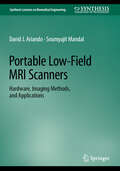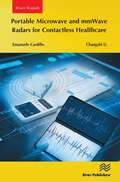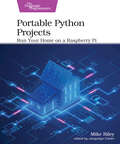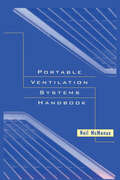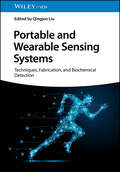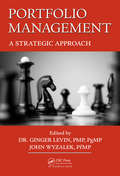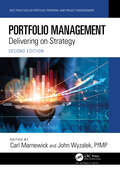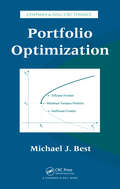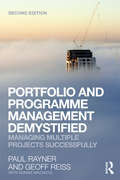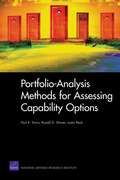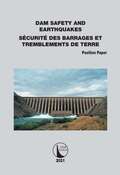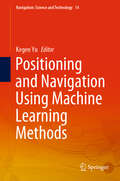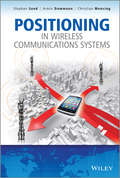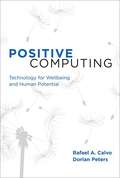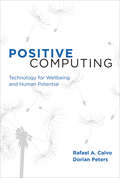- Table View
- List View
Portable Biosensing of Food Toxicants and Environmental Pollutants (Series in Sensors)
by Dimitrios P. Nikolelis Georgia-Paraskevi Nikoleli Theodoros Varzakas Arzum ErdemBiosensors are poised to make a large impact in environmental, food, and biomedical applications, as they clearly offer advantages over standard analytical methods, including minimal sample preparation and handling, real-time detection, rapid detection of analytes, and the ability to be used by non-skilled personnel. Covering numerous applications
Portable Low-Field MRI Scanners: Hardware, Imaging Methods, and Applications (Synthesis Lectures on Biomedical Engineering)
by Soumyajit Mandal David J. AriandoThis book provides readers with an accessible and up-to-date introduction to the field of low-field MRI, which is currently seeing a resurgence in both research and commercial activity. It begins by presenting a historical overview of MRI system design and discussing current developments. It then analyzes the underlying physics of MRI from a semi-classical perspective before describing the major hardware components of low-field scanners (including the magnet, coils, transmitters, receivers, gradient systems, and digital processors) in detail. Several examples of each component are described to solidify the reader’s understanding of the major challenges and trade-offs involved in designing these complex devices. Finally, the issues involved in integrating these components within a working system are highlighted by presenting the architecture, design, and test results of two fully functional low-field MRI scanners that were designed and developed by the authors.
Portable Microwave and mmWave Radars for Contactless Healthcare
by Emanuele Cardillo Changzhi LiThis book is dedicated to modern radars, describing their working principles and providing an overview on recent applications of microwave and mmWave radars for healthcare applications.For many years, the scientific community has put significant effort into the development of advanced microwave and mmWave radar systems for healthcare applications. Young students, researchers, and professionals need a reference book which clearly and concisely describes the main principles of portable radars and identify the relevant applications of this technology.This book is both an entry point for students and researchers new to the topic and a reference for those seeking to explore specific aspects of radar technologies in healthcare. Ultimately, the authors hope to inspire joint efforts directed towards new innovative theories, technologies, techniques, and applications of modern biomedical radar.
Portable Python Projects: Run Your Home On A Raspberry Pi
by Mike RileyDiscover easy ways to control your home with the powerful new Raspberry Pi hardware. Program short Python scripts that will detect changes in your home and react with the instructions you code. Use new add-on accessories to monitor a variety of measurements, from light intensity and temperature to motion detection and water leakage. Expand the base projects with your own custom additions to perfectly match your own home setup. Most projects in the book can be completed in under an hour, giving you more time to enjoy and tweak your autonomous creations. No breadboard or electronics knowledge required! Get to know the latest Raspberry Pi hardware, and create awesome automation solutions for home or work that don't require an electronics degree, cumbersome add-ons, or expensive third-party subscription services. Create easy to run Python scripts on your own that make your Pi do things that would have required a team of automation experts to build only a few years ago. Connect to and control popular home automation lighting systems from a Raspberry Pi. Trigger autonomous actions based on movement, temperature, and timer events. Power on your own computer and appliances using your voice. Remotely control infrared-enabled consumer electronics, create chatbots to retrieve personalized items of interest, and implement a temperature-monitoring room fan. These are just some of the projects that the book will show you how to make. Most projects can be completed and operational in under an hour, and do not require any messy schematics or a spaghetti bowl of wires and breadboard-attached circuits to operate. Control your home or office exactly the way you want instead of relying on an expensive mysterious box of third-party technology to do it for you. What You Need: Raspberry Pi (Pi 4 Model B or higher recommended) running Raspberry Pi OS
Portable Ventilation Systems Handbook
by Neil McManusPortable ventilation systems provide an option for supplementing installed ventilation, as well as providing a system for ventilation where none exists. Portable Ventilation Systems Handbook discusses the various types of portable ventilation systems currently in use, their advantages and disadvantages, and what systems works best for what function.
Portable and Wearable Sensing Systems: Techniques, Fabrication, and Biochemical Detection
by Qingjun LiuPortable and Wearable Sensing Systems Discover the sensors of the future with this comprehensive guide Chemical sensors and biosensors have advanced enormously in recent decades, driven by growth in other technological areas and the refinement of manufacturing processes. Advances, especially, in wireless technology and flexible electronics have dramatically increased the practicality and availability of portable or wearable sensing systems. These have the potential to revolutionize disease diagnosis, food analysis, and environment monitoring at the point of care. Portable and Wearable Sensing Systems: Techniques, Fabrication, and Biochemical Detection introduces these groundbreaking technologies and the underlying principles which make them possible. Beginning with an overview of the foundational optics and electrochemistry which power these systems, the book surveys methods of fabrication, applications, and projected future developments. The result is a comprehensive introduction to an essential medical and biochemical technology. Portable and Wearable Sensing Systems readers will also find: Treatment of body fluid detection, exhaled breath sensing, ingestible devices, and moreDetailed discussion of sensing system types including scattering, colorimetric, and chemiluminescenceForward-looking attention to the latest advances in every chapter Portable and Wearable Sensing Systems is ideal for analytical chemists, materials scientists, bioengineers, biochemists, and anyone working with sensing technologies.
Portals and Libraries
by Sarah C. MichalakCutting-edge information about providing access to research library usersThe ultimate goal of librarians is to provide comprehensive informational access to library users. Portals and Libraries provides an in-depth look at various libraries&’ challenges and the cutting-edge technology used in providing high-quality electronic access to users through portal systems. Respected authorities detail efforts to build a new kind of search and retrieval system that includes access to the Web as well as other vital collections and academic resources. The book discusses the implementation of access systems and their supporting technology, and spotlights strategies designed to encourage quality system-user feedback, increase the cooperation and diligence of staff, and more. Portals and Libraries comprehensively reviews library portals from their roots to their current state, with a look at assorted products, their implementation issues, and each one&’s advantages and shortcomings. The overall state of the portal system today as well as where it is heading in the future is examined in detail. The book also provides the ARL Scholars Portal Working Group Final Report from May 2002 summarizing the group&’s work from its inception, and includes their recommendations of key portal features and needed functions. The text includes helpful screenshots, useful descriptive figures, and extensive references.Portals and Libraries discusses: the history of library portals the MyLibrary@NCState Web portal after five years of use "Portals to the World" Library of Congress guide to Web resources the role integrated library systems will play in the future of portals features and services to be added to library portals for greater success portal technologies-their structures and functioning planning portal implementation online catalogs usability testing and interface design nine key issues that will impact the future of portal developmentPortals and Libraries is crucial reading for library educators and students, college and research librarians in reference, library system professionals, and technical services professionals focused on applying cutting-edge technology to library services.
Portfolio Management: A Strategic Approach (Best Practices In Portfolio, Program, And Project Management Ser. #17)
by Ginger Levin; John WyzalekRecognizing the importance of selecting and pursuing programs, projects, and operational work that add sustainable business value that benefits end users, the Project Management Institute (PMI) issued its first Standard on Portfolio Management in 2006. In 2014, it launched the Portfolio Management Professional (PfMP) credential-which several of the
Portfolio Management: Delivering on Strategy (Best Practices in Portfolio, Program, and Project Management #17)
by Carl Marnewick John WyzalekPortfolio management is becoming the ‘must have’ for organizations to prosper and survive in this decade and beyond. No longer can the organizational focus be one of following best and repeatable practices as resource limitations mean only those programs, projects, and operational work that add business value can and should be pursued. Executives are focusing on strategic ability and managing complexity, which can only be done through a disciplined portfolio process in ensuring the best mix of programs, projects, and operational work is under way. In turn, the portfolio is constantly in flux as difficult decisions are made if a project, for example, is no longer contributing to business value and providing benefits and should be terminated to reallocate resources to one of higher priority. Commitment to this difficult approach is necessary at all levels, and communication is required so everyone knows how their work contributes to the organization’s strategic goals and objectives. Portfolio Management: Delivering on Strategy, Second Edition focuses on the benefits of portfolio management to the organization. Its goal is to provide senior executives a view on how portfolio management can deliver organizational strategy. The emphasis is on the specific aspects within the portfolio management discipline and how each aspect should be managed from a business perspective and not necessarily from a portfolio management perspective. Highlights of the book include: Agile portfolio management Delivering organizational value Portfolio management and uncertainty Portfolio governance Marketing a portfolio Portfolio management success Starting with a review of the project portfolio concept and its development, this book is a reference for executives and practitioners in the field, as well as a students and researchers studying portfolio management.
Portfolio Optimization (Chapman and Hall/CRC Financial Mathematics Series)
by Michael J. BestEschewing a more theoretical approach, Portfolio Optimization shows how the mathematical tools of linear algebra and optimization can quickly and clearly formulate important ideas on the subject. This practical book extends the concepts of the Markowitz "budget constraint only" model to a linearly constrained model.Only requiring elementary linear algebra, the text begins with the necessary and sufficient conditions for optimal quadratic minimization that is subject to linear equality constraints. It then develops the key properties of the efficient frontier, extends the results to problems with a risk-free asset, and presents Sharpe ratios and implied risk-free rates. After focusing on quadratic programming, the author discusses a constrained portfolio optimization problem and uses an algorithm to determine the entire (constrained) efficient frontier, its corner portfolios, the piecewise linear expected returns, and the piecewise quadratic variances. The final chapter illustrates infinitely many implied risk returns for certain market portfolios.Drawing on the author’s experiences in the academic world and as a consultant to many financial institutions, this text provides a hands-on foundation in portfolio optimization. Although the author clearly describes how to implement each technique by hand, he includes several MATLAB® programs designed to implement the methods and offers these programs on the accompanying downloadable resources.
Portfolio and Programme Management Demystified: Managing Multiple Projects Successfully
by Geoff Reiss Paul RaynerYou’re now responsible for a programme, or you’ve got a portfolio to manage? Where do you start? Right here! Projects are not simply the bread and butter of an organisation. Form them into programmes or portfolios and they can be prioritised and integrated to deliver change to your organization in line with your strategic vision. You will be able to control costs and risks and bring together a complex series of themes effectively. This overhauled second edition now combines portfolio management as a parallel theme with programme management, and it is brought in line with the current thinking of the Association for Project Management and the Project Management Institute. It is written for managers in both the public and private sectors. This new edition includes half a dozen short case studies (from Belgium’s Fortis Bank, a software company, local government, and central government), along with more on cross-functional management. Together with Project Management Demystified, also from Routledge (third edition, 2007), it provides the tools to manage your projects, your programmes and your portfolio to a very high level.
Portfolio-Analysis Methods for Assessing Capability Options
by Justin Beck Paul K. Davis Russell D. ShaverAn analytical framework and methodology for capability-area reviews is described, along with new tools to support capabilities analysis and strategic-level defense planning in the Defense Department and the Services. BCOT generates and screens preliminary options, and the Portfolio-Analysis Tool (PAT) is used to evaluate options that pass screening. The concepts are illustrated with applications to Global Strike and Ballistic Missile Defense. Recommendations are made for further defense-planning research.
Portrait of a Burger as a Young Calf: The True Story of One Man, Two Cows, and the Feeding of a Nation
by Peter LovenheimWhen Lovenheim's young daughter asks where hamburger comes from, he sets out to find a detailed answer to her question. He visits farms in New York state and buys two beef calves to follow through the beef production process. He presents a lot of information in a way which is clear and readable. He treats the farmers' actions and decision with respect and compassion even when he is dealing with the hard lives of the animals and their keepers. The author shares his own struggles concerning the slaughter of animals especially his own two cows. He interviews folks who revere cows and those who relish their best steaks. Excellent descriptions. Possibly a bleak subject, but definitely a captivating book.
Portsmouth Firefighting (Images of America)
by Steven E. AchillesIn September 1756, with only fire buckets, two hand tubs, and citizen volunteers safeguarding the Colonial seaport, Portsmouth decided to organize and regulate its fire protection. By 1852, the Portsmouth Fire Department boasted six suction engines and in 1864 entered the age of steam power when the first steam fire engine was delivered. Disastrous fires and a growing city required the department to modernize as it moved into the 20th century. The department's first motorized engine was purchased in 1912, and by 1921, there was a new central fire station along with a new gasoline-powered ladder truck. Through an exceptional collection of photographs, Portsmouth Firefighting richly illustrates the story and tradition of a fire department forever connected to its brave firefighters, their magnificent fire engines, and the spectacular blazes they fought.
Portsmouth Harbor's Military and Naval Heritage (Images of America)
by Glen M. Williford Leo K. Polaski Nelson H. LawryIncluding more than two hundred vintage photographs and illustrations, Portsmouth Harbor's Military and Naval Heritage chronicles the history of the Piscataqua River's naval shipyard and harbor defenses. Long before it became home to one of the U.S. Navy's first federal shipyards, the harbor at Portsmouth, New Hampshire, and Kittery, Maine, was protected by gun batteries, mainly at Fort Point, New Castle, New Hampshire. By the end of World War II, modern concrete batteries mounting guns of ever longer range had been constructed at this and three other forts straddling the river's mouth. These fortifications reflected the increasingly important role of the shipyard, dedicated after 1917 to building submarines that contributed significantly to the World War II victory.
Portuguese Philosophy of Technology: Legacies and contemporary work from the Portuguese-Speaking Community (Philosophy of Engineering and Technology #43)
by Helena Mateus JerónimoThis volume is a collection of essays of a philosophical nature on the subject of technology, introducing authors from the Portuguese-speaking community, namely from Portugal itself, Africa and Brazil. Their contributions detail a unique perspective on technology, placing this important topic within the historical, ideological and social contexts of their countries, all of which share a common language. The shared history of these countries and the cultural and economic specificities of each one have stimulated singular insights into these thinkers’ reflections.The essays are thematically diverse. Among the topics covered are technogenic knowledge, visions of technology, risks and uncertainties, mediatization, digitalization, and datafication, engineering practice and ethics, alternative technoscientific strategies, ontotechnologies of the body, virtual and archive. The contributions also explore other themes that are more closely related to the semi-peripheral world, such as technological dependence and the incorporation of Western technology into the social structure of ancestral communities.This book appeals to students and researchers and provides a voice to authors whose work are not usually available in English-language publications. It serves as an ideal guide for all those who seek rigorous and geographically widespread knowledge regarding thinking on technology in several Portuguese-speaking countries.
Position Paper Dam Safety and Earthquakes (ICOLD Bulletins Series)
by Nathalie SchaunerEarthquakes have always been a significant aspect of the design and safety of dams. This position paper deals with the seismic safety of large dams, based on experiences with large earthquakes in Japan (Tohoku earthquake, 2011, Richter magnitude 9.0), in China (Wenchuan earthquake, 2008, Richter magnitude 8.0) and in Chile (Maule earthquake, 2010, Richter magnitude 8.8). It presents ways to prevent key aspects of large dam failure under severe seismic conditions with a focus on design instead of on earthquake prediction. This is done by considering the prevention of uncontrolled rapid release of water of a storage dam under full reservoir conditions in relation to expected seismic conditions. This position paper is composed by the Committee on Seismic Aspects of Dam Design of The International Committee of Large Dams. Les tremblements de terre ont toujours été un aspect important de la conception et de la sécurité des barrages. Ce document de synthèse traite de la sécurité sismique des grands barrages, en se fondant sur l’expérience acquise lors de grands séismes au Japon (séisme de Tohoku, 2011, magnitude 9,0 sur l’échelle de Richter), en Chine (séisme de Wenchuan, 2008, magnitude 8,0 sur l’échelle de Richter) et au Chili (séisme de Maule, 2010, magnitude 8,8 sur l’échelle de Richter). Il présente des moyens de prévenir les aspects clés de la défaillance des grands barrages dans des conditions sismiques sévères en mettant l’accent sur la conception plutôt que sur la prévision des séismes. Pour ce faire, on examine la prévention d’une libération rapide et incontrôlée de l’eau d’un barrage de stockage dans des conditions de réservoir plein par rapport aux conditions sismiques prévues. Cet argumentaire est composé par le Comité sur les Aspects Sismiques des Projets de Barrages de la Commission Internationale des Grands Barrages.
Position Sensorless Control Techniques for Permanent Magnet Synchronous Machine Drives
by Guoqiang Zhang Gaolin Wang Dianguo XuThe book focuses on position sensorless control for PMSM drives, addressing both basic principles and experimental evaluation. It provides an in-depth study on a number of major topics, such as model-based sensorless control, saliency-based sensorless control, position estimation error ripple elimination and acoustic noise reduction. Offering a comprehensive and systematic overview of position sensorless control and practical issues it is particularly suitable for readers interested in the sensorless control techniques for PMSM drives. The book is also a valuable resource for researchers, engineers, and graduate students in fields of ac motor drives and sensorless control.
Position Sensors
by David S. NyceA resource on position sensor technology, including background, operational theory, design and applications This book explains the theory and applications of the technologies used in the measurement of linear and angular/rotary position sensors. The first three chapters provide readers with the necessary background information on sensors. These chapters review: the working definitions and conventions used in sensing technology; the specifications of linear position transducers and sensors and how they affect performance; and sensor output types and communication protocols. The remaining chapters discuss each separate sensor technology in detail. These include resistive sensors, cable extension transducers, capacitive sensors, inductive sensors, LVDT and RVDT sensors, distributed impedance sensors, Hall Effect sensors, magnetoresistive sensors, magnetostrictive sensors, linear and rotary encoders, and optical triangulation position sensors. Discusses sensor specification, theory of operation, sensor design, and application criteria Reviews the background history of the linear and angular/rotary position sensors as well as the underlying engineering techniques Includes end-of-chapter exercises Position Sensors is written for electrical, mechanical, and material engineers as well as engineering students who are interested in understanding sensor technologies.
Position and Nearshore Mooring: Class Theory and Practice (Springer Series on Naval Architecture, Marine Engineering, Shipbuilding and Shipping #23)
by Alexander Arnfinn OlsenThis book provides a summary of the Class Rules and Guides for mooring systems so that they are easier to navigate and therefore implement. Mooring systems have been evolving in design, analysis, operating management, and other areas to meet the challenges of safety and efficiency. To ensure these challenges are met, Class Rules and Guides are developed and updated to keep pace with the maritime industry. This has resulted in a complex library of Class Rules and Guides. Many requirements are repeated throughout these Class Rules and Guides making use and maintenance of Class Rules/Guides increasingly cumbersome and bureaucratic. In addition to the consolidation of the current requirements, this book also includes guidance in the following areas based on the latest industry knowledge and experiences: Vortex-Induced Motion (VIM) effect. Bending-tension fatigue of mooring chains. Fiber rope mooring criteria. Mooring systems in squalls. Dynamically installed anchors. Anchor holding capacity. Mooring analysis methodology. Thruster-assisted mooring.
Positioning and Location-based Analytics in 5G and Beyond
by Stefania Bartoletti; Nicola Blefari MelazziPOSITIONING AND LOCATION-BASED ANALYTICS IN 5G AND BEYOND Understand the future of cellular positioning with this introduction The fifth generation (5G) of mobile network technology are revolutionizing numerous aspects of cellular communication. Location information promises to make possible a range of new location-dependent services for end users and providers alike. With the new possibilities of this location technology comes a new demand for location-based analytics, a new paradigm for generating and analyzing dynamic location data for a wide variety of purposes. Positioning and Location-based Analytics in 5G and Beyond introduces the foundational concepts related to network localization, user positioning, and location-based analytics in the context of cutting-edge mobile networks. It includes information on current location-based technologies and their application, and guidance on the future development of location systems beyond 5G. The result is an accessible but rigorous guide to a bold new frontier in cellular technology. Positioning and Location-based Analytics in 5G and Beyond readers will also find: Contributions from leading researchers and industry professionals High-level insights into 5G and its future evolution In-depth coverage of subjects such as positioning enablers, location-aware network management, reference standard architectures, and more Positioning and Location-based Analytics in 5G and Beyond is ideal for researchers and industry professionals with an understanding of network communications and a desire to understand the future of the field.
Positioning and Navigation Using Machine Learning Methods (Navigation: Science and Technology #14)
by Kegen YuThis is the first book completely dedicated to positioning and navigation using machine learning methods. It deals with ground, aerial, and space positioning and navigation for pedestrians, vehicles, UAVs, and LEO satellites. Most of the major machine learning methods are utilized, including supervised learning, unsupervised learning, deep learning, and reinforcement learning. The book presents both fundamentals and in-depth studies as well as practical examples in positioning and navigation. Extensive data processing and experimental results are provided in the major chapters through conducting experimental campaigns or using in-situ measurements.
Positioning in Wireless Communications Systems
by Stephan Sand Christian Mensing Armin DammannPositioning in Wireless Communications Systems explains the principal differences and similarities of wireless communications systems and navigation systems. It discusses scenarios which are critical for dedicated navigation systems such as the Global Positioning System (GPS) and which motivate the use of positioning based on terrestrial wireless communication systems.The book introduces approaches for determination of parameters which are dependent on the position of the mobile terminal and also discusses iterative algorithms to estimate and track the position of the mobile terminal. Models for radio propagation and user mobility are important for performance investigations and assessments using computer simulations. Thus, channel and mobility models are explored, especially focussing on critical navigation environments like urban or indoor scenarios.Positioning in Wireless Communications Systems examines advanced algorithms such as hybrid data fusion of satellite navigation and positioning with wireless communications and cooperative positioning among mobile terminals.. The performance of the discussed positioning techniques are explored on the basis of already existing and operable terrestrial wireless communication systems such as GSM, UMTS, or LTE and it is shown how positioning issues are fixed in respective standards.Written by industry experts working at the cutting edge of technological development, the authors are well placed to give an excellent view on this topic, enabling in-depth coverage of current developments.Key features* Unique in its approach to dealing with a heterogeneous system approach, different cell structures and signal proposals for future communications systems* Covers hybrid positioning investigating how GNSS and wireless communications positioning complement each other* Applications and exploitation of positioning information are discussed to show the benefits of including this information in several parts of a wireless communications system
Positive Computing
by Rafael A. Calvo Dorian PetersOn the eve of Google's IPO in 2004, Larry Page and Sergey Brin vowed not to be evil. Today, a growing number of technologists would go further, trying to ensure that their work actively improves people's lives. Technology, so pervasive and ubiquitous, has the capacity to increase stress and suffering; but it also has the less-heralded potential to improve the well-being of individuals, society, and the planet. In this book, Rafael Calvo and Dorian Peters investigate what they term "positive computing" -- the design and development of technology to support psychological well-being and human potential. Calvo and Peters explain that technologists' growing interest in social good is part of a larger public concern about how our digital experience affects our emotions and our quality of life -- which itself reflects an emerging focus on humanistic values in many different disciplines. Synthesizing theory, knowledge, and empirical methodologies from a variety of fields, they offer a rigorous and coherent foundational framework for positive computing. Sidebars by experts from psychology, neuroscience, human--computer interaction, and other disciplines supply essential context. Calvo and Peters examine specific well-being factors, including positive emotions, self-awareness, mindfulness, empathy, and compassion, and explore how technology can support these factors. Finally, they offer suggestions for future research and funding.SidebarsTimothy N. Bickmore, Jeremy Bailenson, danah boyd, Jane Burns, David R. Caruso, Mihaly Csikszentmihalyi, Felicia Huppert, Mary-Helen Immordino-Yang, Adele Krusche and J. Mark G. Williams, Jane McGonigal, Jonathan Nicholas, Don Norman, Yvonne Rogers
Positive Computing: Technology for Wellbeing and Human Potential
by Rafael A. Calvo Dorian PetersA case for building a digital environment that can make us happier and healthier, not just more productive, and a theoretical framework for doing so.On the eve of Google's IPO in 2004, Larry Page and Sergey Brin vowed not to be evil. Today, a growing number of technologists would go further, trying to ensure that their work actively improves people's lives. Technology, so pervasive and ubiquitous, has the capacity to increase stress and suffering; but it also has the less-heralded potential to improve the well-being of individuals, society, and the planet. In this book, Rafael Calvo and Dorian Peters investigate what they term “positive computing”—the design and development of technology to support psychological well-being and human potential. Calvo and Peters explain that technologists' growing interest in social good is part of a larger public concern about how our digital experience affects our emotions and our quality of life—which itself reflects an emerging focus on humanistic values in many different disciplines. Synthesizing theory, knowledge, and empirical methodologies from a variety of fields, they offer a rigorous and coherent foundational framework for positive computing. Sidebars by experts from psychology, neuroscience, human–computer interaction, and other disciplines supply essential context. Calvo and Peters examine specific well-being factors, including positive emotions, self-awareness, mindfulness, empathy, and compassion, and explore how technology can support these factors. Finally, they offer suggestions for future research and funding.SidebarsTimothy N. Bickmore, Jeremy Bailenson, danah boyd, Jane Burns, David R. Caruso, Mihaly Csikszentmihalyi, Felicia Huppert, Mary-Helen Immordino-Yang, Adele Krusche and J. Mark G. Williams, Jane McGonigal, Jonathan Nicholas, Don Norman, Yvonne Rogers

